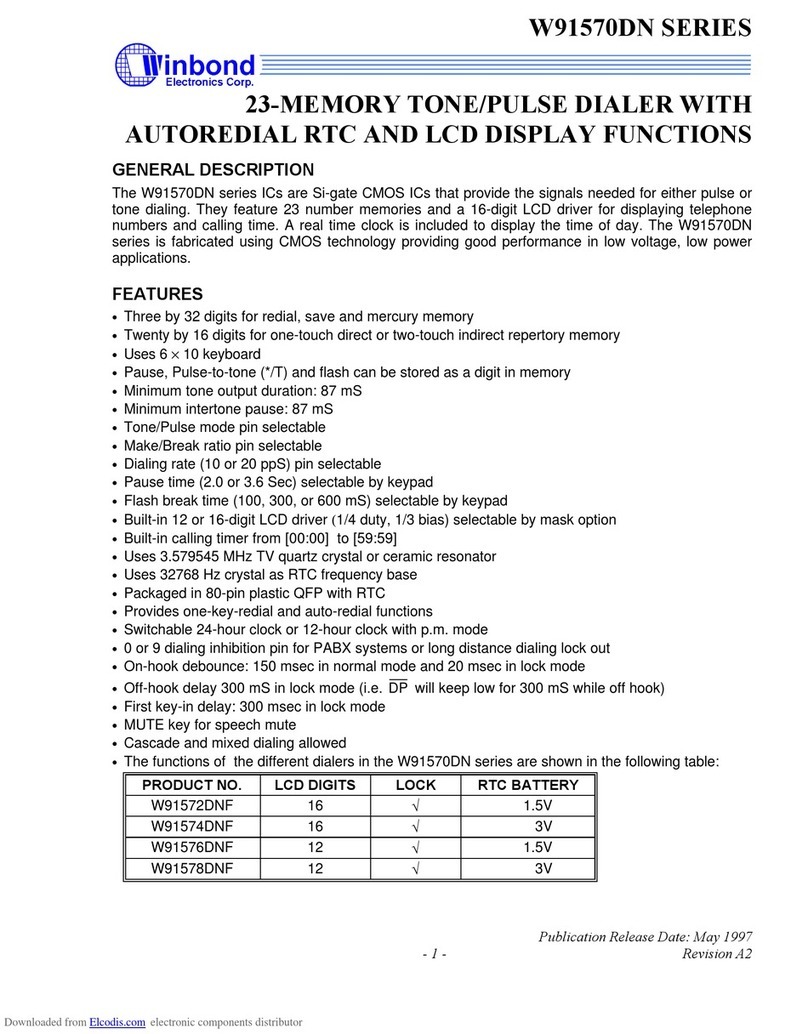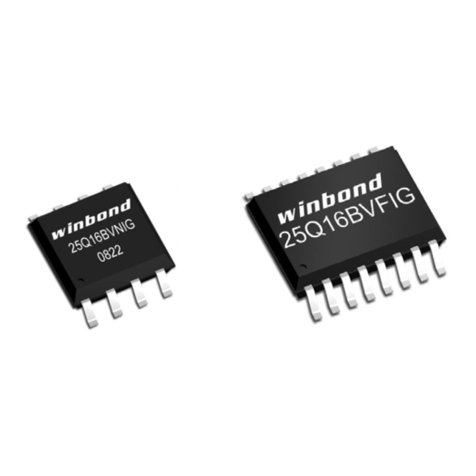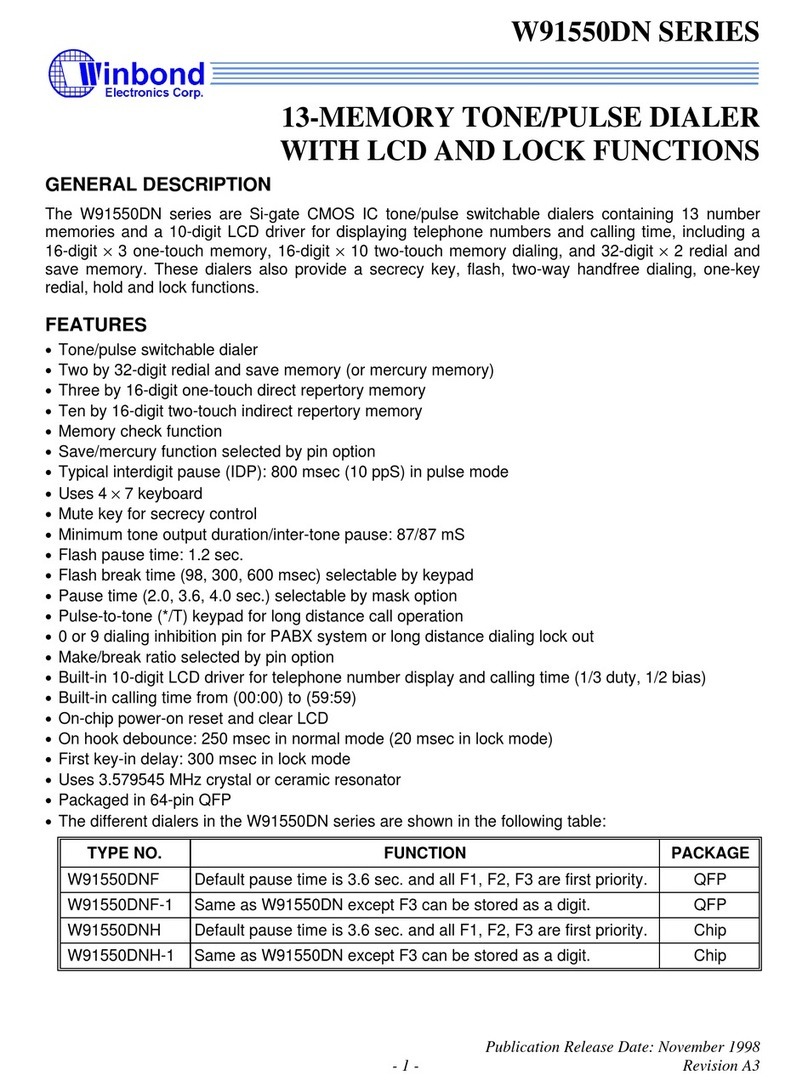
W25Q80BV
Publication Release Date: Augest 01, 2012
- 5 - Revision G
1. GENERAL DESCRIPTION
The W25Q80BV (8M-bit) Serial Flash memory provides a storage solution for systems with limited space,
pins and power. The 25Q series offers flexibility and performance well beyond ordinary Serial Flash
devices. They are ideal for code shadowing to RAM, executing code directly from Dual/Quad SPI (XIP)
and storing voice, text and data. The device operates on a single 2.7V to 3.6V power supply with current
consumption as low as 4mA active and 1µA for power-down.
The W25Q80BV array is organized into 4,096 programmable pages of 256-bytes each. Up to 256 bytes
can be programmed at a time. Pages can be erased in groups of 16 (4KB sector erase), groups of 128
(32KB block erase), groups of 256 (64KB block erase) or the entire chip (chip erase). The W25Q80BV
has 256 erasable sectors and 16 erasable blocks respectively. The small 4KB sectors allow for greater
flexibility in applications that require data and parameter storage. (See figure 2.)
The W25Q80BV supports the standard Serial Peripheral Interface (SPI), and a high performance
Dual/Quad output as well as Dual/Quad I/O SPI: Serial Clock, Chip Select, Serial Data I/O0 (DI), I/O1
(DO), I/O2 (/WP), and I/O3 (/HOLD). SPI clock frequencies of up to 104MHz are supported allowing
equivalent clock rates of 208MHz (104MHz x 2) for Dual I/O and 416MHz (104MHz x 4) for Quad I/O
when using the Fast Read Dual/Quad I/O instructions. These transfer rates can outperform standard
Asynchronous 8 and 16-bit Parallel Flash memories. The Continuous Read Mode allows for efficient
memory access with as few as 8-clocks of instruction-overhead to read a 24-bit address, allowing true
XIP (execute in place) operation.
A Hold pin, Write Protect pin and programmable write protection, with top, bottom or complement array
control, provide further control flexibility. Additionally, the device supports JEDEC standard manufacturer
and device identification with a 64-bit Unique Serial Number.
2. FEATURES
Family of SpiFlash Memories
–W25Q80BV: 8M-bit/1M-byte (1,048,576)
–256-byte per programmable page
–Standard SPI: CLK, /CS, DI, DO, /WP, /Hold
–Dual SPI: CLK, /CS, IO0, IO1, /WP, /Hold
–Quad SPI: CLK, /CS, IO0, IO1, IO2, IO3
Highest Performance Serial Flash
–104MHz Dual/Quad SPI clocks
–208/416MHz equivalent Dual/Quad SPI
–50MB/S continuous data transfer rate
–Up to 8X that of ordinary Serial Flash
–More than 100,000 erase/program cycles(1)
–More than 20-year data retention
Efficient “Continuous Read Mode”
–Low Instruction overhead
–Continuous Read with 8/16/32/64-Byte Wrap
–As few as 8 clocks to address memory
–Allows true XIP (execute in place) operation
–Outperforms X16 Parallel Flash
Low Power, Wide Temperature Range
–Single 2.7 to 3.6V supply
–4mA active current, <1µA Power-down current
–-40°C to +85/105°C operating range
Flexible Architecture with 4KB sectors
–Uniform Sector/Block Erase (4/32/64K-bytes)
–Program one to 256 bytes
–Erase/Program Suspend & Resume
Advanced Security Features
–Software and Hardware Write-Protect
–Top/Bottom, 4KB complement array protection
–Lock-Down and OTP array protection
–64-Bit Unique Serial Number for each device
–Discoverable Parameters (SFDP) Register
–3X256-Byte Security Registers with OTP locks
–Volatile & Non-volatile Status Register Bits
Space Efficient Packaging(2)
–8-pin SOIC/VSOP 150/208-mil
–8-pad USON 2x3-mm
–8-pad WSON 6x5-mm
–8-pin PDIP 300-mil
–24-ball TFBGA 8x6-mm (6x4/5x5 ball array)
–Contact Winbond for KGD and other options
Note 1. More than 100,000 Block Erase/Program cycles for Industrial and Automotive temperature; more than
10,000 full chip Erase/Program cycles tested in compliance with AEC-Q100.































